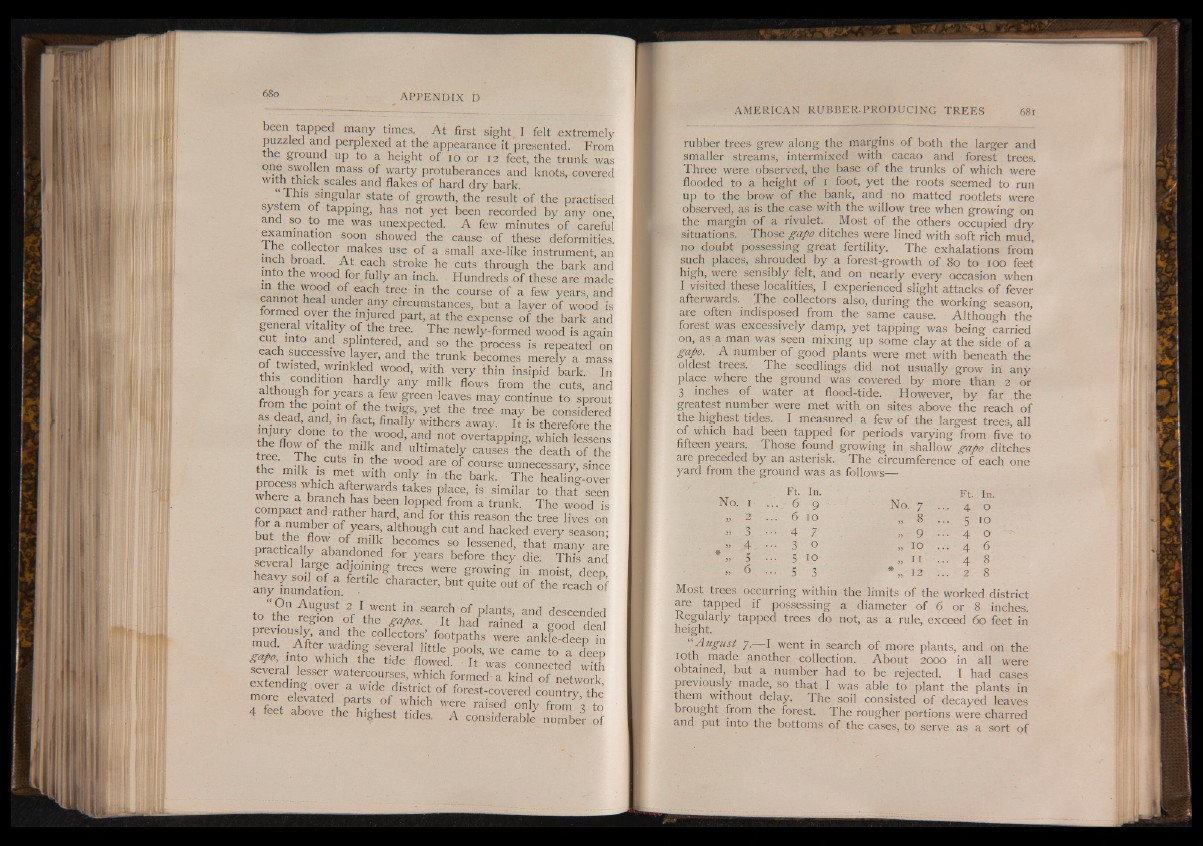
been tapped many times. A t first sight I felt extremely
puzzled and perplexed at the appearance it presented. From
the ground up to a height of 10 or 12 feet, the trunk was
OI?f. swollen mass of warty protuberances and knots, covered
with thick scales and flakes of hard dry bark.
This singular state of growth, the result of the practised
sys em of tapping, has not yet been recorded by any one,
and so to me was unexpected. A few minutes of careful
examination soon showed the cause of these deformities.
• n u° j t0r makes use ° f a small axe-like instrument, an
inch broad. A t each stroke he cuts through the bark and
into the wood for fully an inch. Hundreds of these are made
*n of each tree in the course of a few years, and
eal ^ der anF circumstances, but a layer of wood 'is
S S t f T V f Vnjure part) at the expense of the bark and
general vitality of the tree. The newly-formed wood is again
in o and splintered, and so the process is repeated on
each successive ayer, and the trunk becomes merely a mass
of twisted, wrinkled wood, with very thin insipid bark. In
al thoncrh'f hardly any milk flows from the cuts, and
frnm tP T O ? few g^en leaves may continue to sprout
I P S f i l S f l 1 m m m yet the tree maP ^ considered
iniurv /lnn^ i'H fu ’ J 7 Wlthers away- It is therefore the
the flow of ° n W° ° f ’ a,nd not overtapping, which lessens
tree T h f 1 ™ Ik ^ d ultimately causes the death of the
the m i? • .ln - f WOod are of course unnecessary, since
the milk is met with only in the bark. The healing-over
d i n hfhe rT dS 1 1 pkGe’where a branch has been lopped from "a tSruimnkil.a r Ttoh et hwa *o oBd is
S S n S ^ r fther har1 ’ uand f° r tWs reaSOn the tree lives on
but thi flo ° / ean’ al though cut and hacked every season;
pp raaccttiiccaallllyv Tahbaa ndoned cfboerC °ymeaerSs Sb°e floerSeS etnheedy’ Mdie iTlhils a^nd
heavv sofl'of * 3 Rowing7
fah1' CharaCter' but ^ « - h i f
to “the" ™f„nst „2f I«,we” t v sea7 h f'lants. m W aM me region of the gapos. It had rained a eood deal
previously and the collectors; footpaths were ankle-deep in
. -^Iterwvading several little pools, we came to a deep
several le e tlde flowed. It was connected with
several lesser watercourses, which formed a kind of network
more" f T a wide district of forest-covered country the
. ore elevated parts of which were raised only from 3 to
4 feet above the highest tides. A considerable7 number of
rubber trees grew along the margins of both the larger and
smaller streams, intermixed with cacao and forest trees.
Three were observed, the base of the trunks of which were
flooded to a height of 1 foot, yet the roots seemed to run
up to the brow of the bank, and no matted rootlets were
observed, as is the case with the willow tree when growing on
the margin of a rivulet. Most of the others occupied dry
situations. Those gapo ditches were lined with soft rich mud
no doubt possessing great fertility. The exhalations from
such places, shrouded by a forest-growth of 80 to 100 feet
high, were sensibly felt, and on nearly every occasion when
I visited these localities, I experienced slight attacks of fever
afterwards. The collectors also, during the working season
are often indisposed from the samp cause. Although the
forest was excessively damp, yet tapping was being carried
on, as a man was seen mixing up some clay at the side of a
gapo. A number of good plants were met with beneath the
oldest trees. The seedlings did not usually grow in any
place where the ground was covered by more than 2 or
3 inches of water at flood-tide. However, by far the
greatest number were met with on sites above the reach of
the highest tides. I measured a few of the largest trees, all
of which had been tapped for periods varying from five to
fifteen years. Those found growing in shallow gapo ditches
are preceded by an asterisk. The circumference of each one
yard from the ground was as follows—
No.
Ft. In. Ft. In.
I .. 6 9 No. 7 4 O
).) 2 . .. 6 10 „ 8 5 IO
J) 3 •■ • 4 „ 9 4 O
* }) JJ
4 ■ 3 0 „ 10 4 6
5 I S 10 ,, 11 4 8
6 . •• s 3 * „ 12 2 8
Most trees occurring within the limits of the worked district
are tapped if possessing a diameter of 6 or 8 inches.
Regularly tapped trees do not, as a rule, exceed 60 feet in
height.
“ August 7.— I went in search of more plants, and on the
10th made another collection. About 2000 in all were
obtained, but a number had to be rejected. I had cases
previously made, so that I was able to plant the plants in
them without delay. The soil consisted of decayed leaves
brought from the forest. The rougher portions were charred
and put into the bottoms of the cases, to serve as a sort of